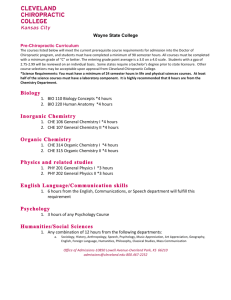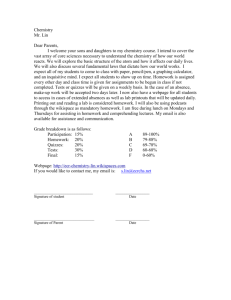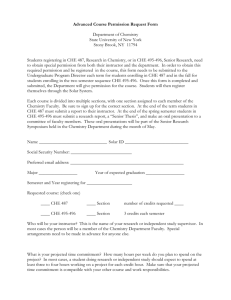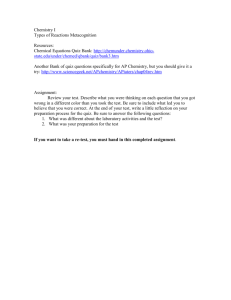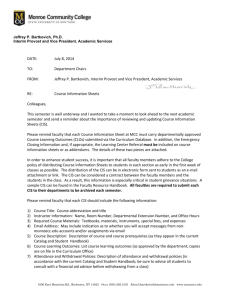CHE 100 Preparatory Chemistry
advertisement
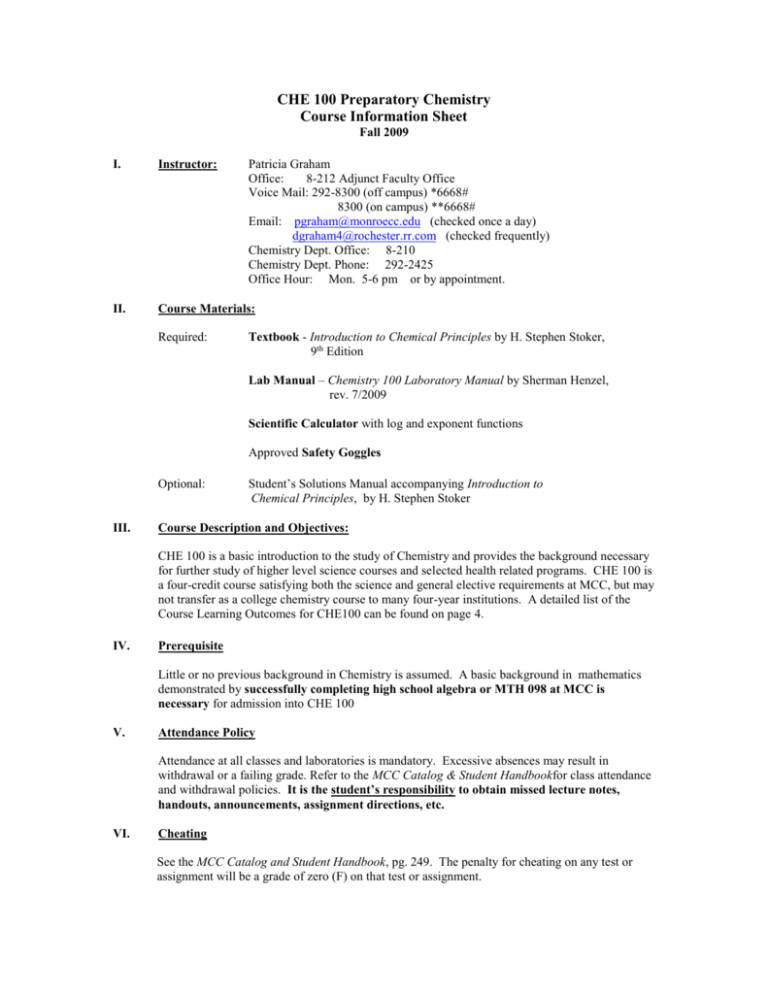
CHE 100 Preparatory Chemistry Course Information Sheet Fall 2009 I. Instructor: II. Course Materials: Required: Patricia Graham Office: 8-212 Adjunct Faculty Office Voice Mail: 292-8300 (off campus) *6668# 8300 (on campus) **6668# Email: pgraham@monroecc.edu (checked once a day) dgraham4@rochester.rr.com (checked frequently) Chemistry Dept. Office: 8-210 Chemistry Dept. Phone: 292-2425 Office Hour: Mon. 5-6 pm or by appointment. Textbook - Introduction to Chemical Principles by H. Stephen Stoker, 9th Edition Lab Manual – Chemistry 100 Laboratory Manual by Sherman Henzel, rev. 7/2009 Scientific Calculator with log and exponent functions Approved Safety Goggles Optional: III. Student’s Solutions Manual accompanying Introduction to Chemical Principles, by H. Stephen Stoker Course Description and Objectives: CHE 100 is a basic introduction to the study of Chemistry and provides the background necessary for further study of higher level science courses and selected health related programs. CHE 100 is a four-credit course satisfying both the science and general elective requirements at MCC, but may not transfer as a college chemistry course to many four-year institutions. A detailed list of the Course Learning Outcomes for CHE100 can be found on page 4. IV. Prerequisite Little or no previous background in Chemistry is assumed. A basic background in mathematics demonstrated by successfully completing high school algebra or MTH 098 at MCC is necessary for admission into CHE 100 V. Attendance Policy Attendance at all classes and laboratories is mandatory. Excessive absences may result in withdrawal or a failing grade. Refer to the MCC Catalog & Student Handbookfor class attendance and withdrawal policies. It is the student’s responsibility to obtain missed lecture notes, handouts, announcements, assignment directions, etc. VI. Cheating See the MCC Catalog and Student Handbook, pg. 249. The penalty for cheating on any test or assignment will be a grade of zero (F) on that test or assignment. VII. Course Requirements and Grading Policy Pg. 2 Maximum benefit from the lectures will be obtained if the student reads the appropriate chapter(s) before it is covered in class. See the attached tentative syllabus. Success in CHE 100 is entirely dependent upon the student’s commitment to hard work and the willingness to PRACTICE skills as they are learned. Labs, Problem Sessions and Worksheets are representative of your effort, attendance and participation: as such, they will comprise 25% of your final grade. Worksheets not completed in class must be finished as homework. Due dates will be announced at the time the work is assigned. Credit will be deducted for assignments which are submitted late. Work which is more than 2 periods late will not be accepted. Exams : Will be non-cumulative. The dates and material to be tested will be confirmed in class approximately one week prior to the exam date. Quizzes: A short quiz will be given at the beginning of every class. A time limit of 10 min. will be strictly enforced. Time extensions will not be granted for any reason. Students requiring additional time for quizzes should arrive early for class. If you arrive late to class for any quiz or exam, you lose the time. If you are very late or absent (regardless of the reason), you will miss that particular quiz/ exam , and you will not be allowed to make it up. There are NO make-up exams, quizzes or labs in this course. THERE ARE NO EXCEPTIONS. 75% of your grade will be derived from: Quizzes worth 10 points each (2 lowest quiz grades will be dropped) 6 Exams (1 hour long) worth 100 points each (1 lowest grade will be dropped) If you miss one of these (regardless of the reason), that will be the grade dropped. 25% of your grade will be derived from labs, and assigned Worksheets Letter grade will be assigned as follows: 90-100 (A) 87-89 (A-) VIII. 73-76 (C+) 70-72 (C) 67-69 (C-) 63-66 (D+) 60-62 ( D) 57-59 (D-) Below 57 F Miscellaneous o o o IX. 83-86 (B+) 80-82 ( B) 77-79 (B-) Please turn off all cell phones and alarms when entering class. If you hand in sloppy work and illegible handwriting, it will be returned to you ungraded. Be prompt and prepared – late arrivals to class are disruptive and rude. Learning Centers It is recommended that students use the Learning Centers to get additional help with concepts learned in the classroom and with their homework. Learning centers are staffed with instructional personnel and may be equipped with computers and software to assist students. On the Brighton campus The Learning Center for Accounting, Math, Psychology, Writing as well as the Electronic Learning Center is located in Bldg. 11, Rm 106. Tutoring in Chemistry may also be obtained at the Interdisciplinary Learning Center, Bldg. 11 Rm 211, and at the Natural Science Education Center, building 9, Rm 134. On Damon Campus the Integrated Learning Center is in Rm. 4-130 and the Electronic Learning Center is in Rm. 4-071 X. Emergency Closings: Pg. 3 If the College is closed due to inclement weather or some other emergency, all Rochester area radio and television stations will be notified no later than 5:30 am, or in the case of a mid-day decision, no later than 3:00pm . Also, the homepage on the MCC website (www.monroecc.edu) will display a message indicating the College is closed. Please do not call the College to avoid overloading the phone line. Class cancellation information is available daily on the web or through the telephone. Simply go to the MCC website (www.monroecc.edu) and under the “Quick Links” window on the homepage, click on “Class Cancellations”. Additionally, class cancellation information is available by dialing 292-2066, press “1” for the Brighton Campus and “2” for the Damon Campus. If possible, please use the web as there could be delays in the voice recordings based on the number of cancellations. Special Notice regarding H1N1 Flu: Fall 2009 brings flu season and this year it is expected to bring the H1N1 variant. I encourage you to take notice of the preventive measures that have been communicated to all students at the college. I support the request that students, faculty and staff stay home when they are ill. I encourage you each to take the contact information for at least two of your classmates, so that you can share notes and information you may miss while absent. Sign below, tear off and return to Instructor. I have read and understood the preceding Course Information Sheet for CHE 100 Preparatory Chemistry Fall, 2009 Instructor – P. Graham I accept the terms and requirements as stated in this document Signature________________________________________________ Date__________ Print your name: _____________________________________________ Pg. 4 CHE 100 Course Learning Outcomes 1. Recognize the importance of measurements and be able to record them to the correct number of significant figures. Use significant figures and scientific notation properly in mathematical operations. Understand and use the metric system, various conversion factors in dimensional analysis, density, percentage, and the three different temperature scales presented. 2. Describe the basic concepts of matter which includes differentiating between the three states, physical/chemical changes and properties, mixtures, pure substances, and being able to write the chemical symbols for the elements. 3. Understand and articulate the fundamental concepts and characteristics of atoms (e.g., identify subatomic particles, atomic number, mass number, and atomic mass), molecules, and chemical formulas. 4. Explain chemical periodicity and electronic structure (periodic law, periodic table, electronic configurations). Classify elements based on various systems and predict elemental characteristics based on trends in the periodic table. 5. Understand why and how bonds form in ionic and molecular compounds. This includes writing electron dot structures, writing chemical formulas for ionic compounds, determining molecular geometry/electronegativity/bond polarity/molecular polarity , and applying IUPAC nomenclature rules . 6. Compute formula mass, percent composition, and molar mass. Understand the mole concept and how it is employed in chemical calculations and chemical formulas. 7. Classify, read, write, and balance chemical equations. Understand the Law of Conservation of Mass. Understand the mole and chemical equation relationship and be able to solve chemical stoichiometry problems. Solve for percent yield. 8. Understand and articulate the gas laws presented and how gas variables relate to each other. Solve for the appropriate gas law. 9. Define types of solutions, terms used to describe solutions, explain solution formation, and apply solubility rules. Compute solution concentrations namely: percents, ppm, ppb, molarity, and dilution. 10. Explain the basic concepts of acids and bases such as: definitions, conjugates, strengths, reactions, and the pH scale.

